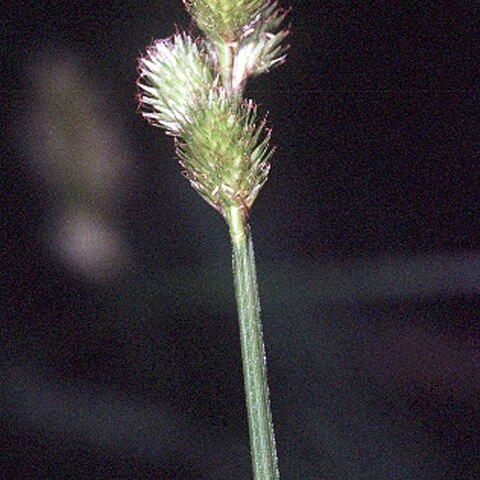Plants densely cespitose. Culms 50–110 cm; vegetative culms with numerous leaves spaced evenly along distal 1/2. Leaves: sheaths adaxially green-veined nearly to collar, with ± triangular white-hyaline area to 3–8 mm proximal to collar, somewhat loose, expanded near summits, ± wing-angled, adaxially firm, summits U-shaped, somewhat thickened, slightly prolonged beyond collar; distal ligules 4–8(–12) mm; blades 4–10 per fertile culm, 15–40 cm × (2–)3–7 mm. Inflorescences erect, dense distally, brown, 2–5(–8) cm × 10–20 mm; proximal internode 2–20 mm; 2d internode 2–13 mm; proximal bracts bristlelike, 1(–8) cm. Spikes 6–15, overlapping or distinct, ovoid-oblong to globose, 6–12(–16) × 4–8 mm, base rounded to tapered, apex rounded. Pistillate scales white-hyaline or pale silvery brown with green midstripe, lanceolate, (1.9–)2.5–3 mm, 1/2 length of and narrower than perigynia, apex acute to acuminate. Perigynia more than (30–)40 per spike, appressed-ascending to ascending, pale green to pale brown, 3–6-veined abaxially, conspicuously or, occasionally, faintly, 2–4-veined adaxially, often somewhat asymmetric, ovate-lanceolate to ovate-elliptic, plano-convex, 3–5.4 × 1.1–1.7 mm, 0.3–0.5 mm thick, margin flat, including wing 0.1–0.5 mm wide; beak tip flat, ciliate-serrulate, abaxial suture with golden to dark brown hyaline margin, distance from beak tip to achene 1.4–2 mm. Achenes oblong-ovate, 1–1.8 × 0.6–0.9 mm, 0.3–0.5 mm thick. 2n = 70.
More
Tufted, aphyllopodic, usually stout, 5–10 dm; main lvs 3–7 mm wide, surpassed by the stems; sheaths ventrally green-veined almost to the summit; spikes 5–15, gynaecandrous, 6–12 mm, ovoid to subglobose or obovoid, usually blunt, rounded to acute at base, sessile, densely to loosely aggregated into an ovoid or oblong cluster 2–5 cm; pistillate scales lanceolate, half to two-thirds as long as the perigynia, merely acute, pale brown with hyaline margins and tip; perigynia numerous (more than 30), appressed-ascending, green or becoming stramineous, 4–5(–5.5) × 1–1.3(–1.6) mm, 3–4 times as long as wide, lanceolate, flat or barely distended over the achene, the wing rather abruptly narrowed about the middle and often obsolete in the lower fourth, obscurely nerved on both sides, gradually tapering into the beak; achene lenticular, 1.5 × 0.5–0.75 mm. Wet woods and meadows; Que. and Me. to Minn., and Neb., s. to Fla., La., and Okla., more common s.

